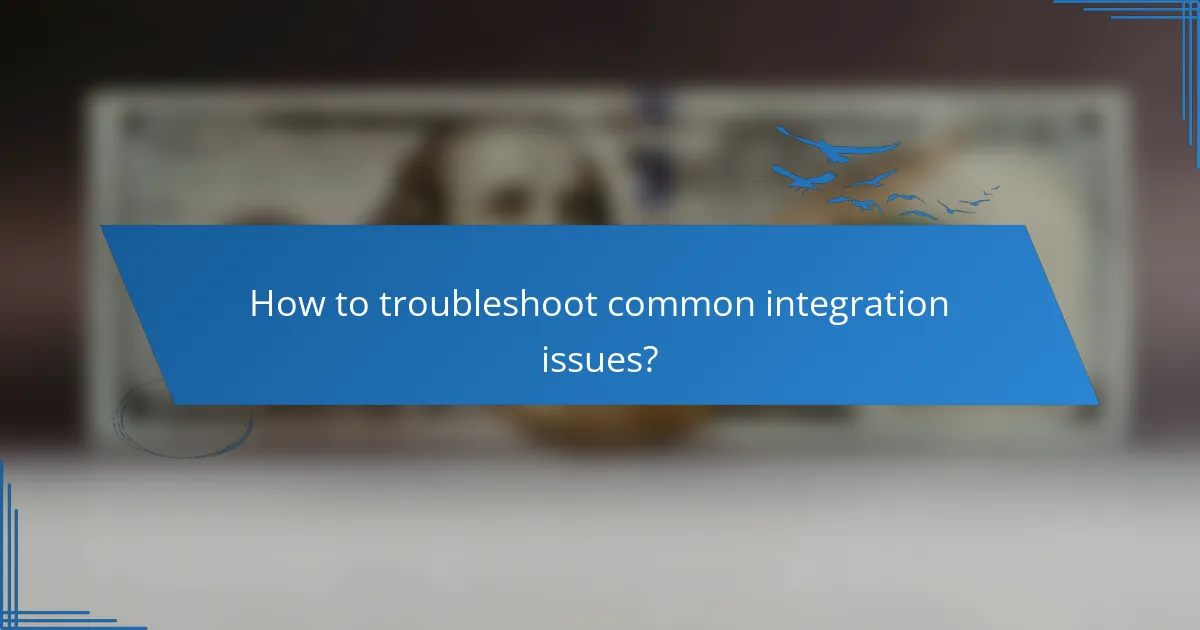Third-party integrations play a crucial role in enhancing the functionality of social media tools, offering users advanced features that streamline processes and improve engagement. By enabling better data analysis and efficient content management, these integrations empower users to develop more effective social media strategies. Selecting the right integrations involves assessing compatibility and user feedback to ensure they align with specific needs and goals.

How do third-party integrations enhance social media tools?
Third-party integrations significantly enhance social media tools by expanding their functionality and providing users with advanced features. These integrations allow for better data analysis, efficient content management, and improved interaction with audiences, ultimately leading to more effective social media strategies.
Improved analytics capabilities
Integrating third-party analytics tools with social media platforms enables users to gather deeper insights into their performance metrics. This can include tracking engagement rates, audience demographics, and content reach, which are crucial for refining marketing strategies.
For example, tools like Google Analytics or Hootsuite Insights can provide comprehensive reports that help identify which posts resonate most with audiences. Users should prioritize integrations that offer customizable dashboards to visualize data effectively.
Streamlined content scheduling
Third-party integrations can simplify the process of scheduling posts across multiple social media channels. Tools such as Buffer or Sprout Social allow users to plan and automate their content distribution, saving time and ensuring consistent posting.
When choosing a scheduling tool, consider features like bulk upload options and optimal posting time suggestions. This can help maximize engagement by ensuring content is shared when audiences are most active.
Enhanced audience engagement features
Integrating audience engagement tools can significantly improve interaction with followers. Features such as chatbots, comment management systems, and polls can foster real-time communication and feedback.
For instance, using a tool like ManyChat for Facebook Messenger can automate responses to common inquiries, enhancing user experience. It’s essential to regularly review engagement metrics to adjust strategies and ensure that audience needs are being met effectively.

What are the best third-party integrations for social media tools?
The best third-party integrations for social media tools enhance functionality, streamline processes, and improve user engagement. Popular options include automation platforms, scheduling tools, and design applications that cater to various needs in social media management.
Zapier for automation
Zapier is a powerful automation tool that connects different apps and services, allowing users to automate repetitive tasks without coding. By creating “Zaps,” users can set triggers and actions that streamline workflows, such as automatically posting new blog entries to social media or adding new followers to a mailing list.
When using Zapier, consider the volume of tasks you need to automate. Most plans offer a limited number of tasks per month, so choose a plan that aligns with your usage. Common pitfalls include over-automating, which can lead to impersonal interactions, so maintain a balance between automation and personal engagement.
Hootsuite for scheduling
Hootsuite is a widely used social media management tool that allows users to schedule posts across multiple platforms from a single dashboard. This integration helps maintain a consistent posting schedule, which is crucial for audience engagement and brand visibility.
To maximize Hootsuite’s effectiveness, plan your content calendar in advance and utilize its analytics features to track engagement metrics. Be cautious of scheduling too far ahead, as trends can change quickly, and you may need to adjust your content strategy accordingly.
Canva for design
Canva is a user-friendly design tool that integrates seamlessly with social media platforms, enabling users to create visually appealing graphics for posts, stories, and ads. Its drag-and-drop interface and extensive library of templates make it accessible for users with varying design skills.
When using Canva, focus on maintaining brand consistency by using your brand colors and fonts. Avoid cluttered designs; instead, aim for simplicity and clarity to capture your audience’s attention. Regularly update your graphics to reflect current trends and seasonal themes, enhancing engagement with your content.

How to choose the right third-party integrations?
Choosing the right third-party integrations involves evaluating compatibility, functionality, and user feedback. Prioritize tools that enhance your existing social media capabilities while aligning with your specific needs and goals.
Assess compatibility with existing tools
Start by ensuring that any third-party integration works seamlessly with your current social media tools. Check for compatibility with platforms you already use, such as scheduling tools, analytics software, or customer relationship management systems.
Consider the technical requirements and whether the integration supports the same data formats and APIs. For example, if you use a specific analytics tool, verify that the integration can pull data from it without manual input.
Evaluate user reviews and case studies
User reviews and case studies provide valuable insights into the effectiveness of third-party integrations. Look for feedback on usability, customer support, and the integration’s impact on social media performance.
Seek out case studies that demonstrate real-world applications and results. This can help you gauge how the integration has benefited other users in similar industries or with comparable goals, allowing you to make a more informed decision.

What are the costs associated with third-party integrations?
The costs associated with third-party integrations can vary widely based on the tools and features selected. Users should consider both ongoing subscription fees and any initial setup costs when budgeting for these integrations.
Subscription fees for premium features
Many social media tools offer premium features through subscription plans that can range from modest monthly fees to more substantial annual costs. These fees often depend on the level of functionality, such as advanced analytics, automation capabilities, or additional user accounts.
For instance, basic plans may start at around $10 to $30 per month, while comprehensive packages can exceed $100 monthly. It’s essential to evaluate which features are necessary for your needs to avoid overspending on unnecessary options.
One-time setup costs
One-time setup costs for third-party integrations can include expenses for configuration, customization, and training. Depending on the complexity of the integration, these costs might range from a few hundred to several thousand dollars.
Consider hiring a professional or consulting service if the integration requires significant technical expertise. Additionally, ensure that you account for any potential downtime during the setup process, which could impact your social media operations.

What are the risks of using third-party integrations?
Using third-party integrations can expose users to various risks, including data privacy issues and potential downtime. Understanding these risks is crucial for maintaining the integrity and reliability of social media tools.
Data privacy concerns
Data privacy is a significant risk when utilizing third-party integrations. These services often require access to sensitive user information, which can lead to unauthorized data sharing or breaches. Users should carefully review the privacy policies of third-party providers to ensure compliance with regulations like GDPR or CCPA.
To mitigate risks, consider limiting the amount of data shared with third-party tools. Use integrations that offer robust encryption and data protection measures. Regularly audit the permissions granted to these services to maintain control over your data.
Potential downtime issues
Third-party integrations can introduce potential downtime issues that affect the functionality of social media tools. If the third-party service experiences outages or performance degradation, it can disrupt your social media operations. This can lead to missed engagement opportunities and impact overall user experience.
To minimize downtime risks, choose reputable third-party providers with a history of reliability. Implement monitoring tools to track the performance of integrations and establish a contingency plan to switch to alternative solutions if necessary. Regularly test integrations to ensure they are functioning as expected.

How to troubleshoot common integration issues?
Troubleshooting common integration issues involves systematically checking settings and logs to identify and resolve problems. Start by verifying your API connections and then delve into error logs for specific insights.
Check API connection settings
Begin by ensuring that your API connection settings are correctly configured. This includes verifying the API keys, endpoints, and any required authentication methods. A small typo or outdated key can prevent successful communication between your social media tool and third-party services.
Additionally, confirm that the permissions granted to the API are appropriate for the actions you want to perform. For instance, if you’re trying to post content, ensure that the API has permission to write to the relevant social media accounts.
Review error logs for insights
Error logs can provide valuable information about what is going wrong with your integrations. Check for specific error codes or messages that can guide your troubleshooting efforts. Many platforms categorize errors, making it easier to identify whether the issue is related to authentication, rate limits, or other factors.
When reviewing logs, look for patterns or recurring issues that may indicate a broader problem. For example, if multiple users are experiencing the same error, it may be a sign of a temporary outage or a configuration issue that needs to be addressed at the system level.
